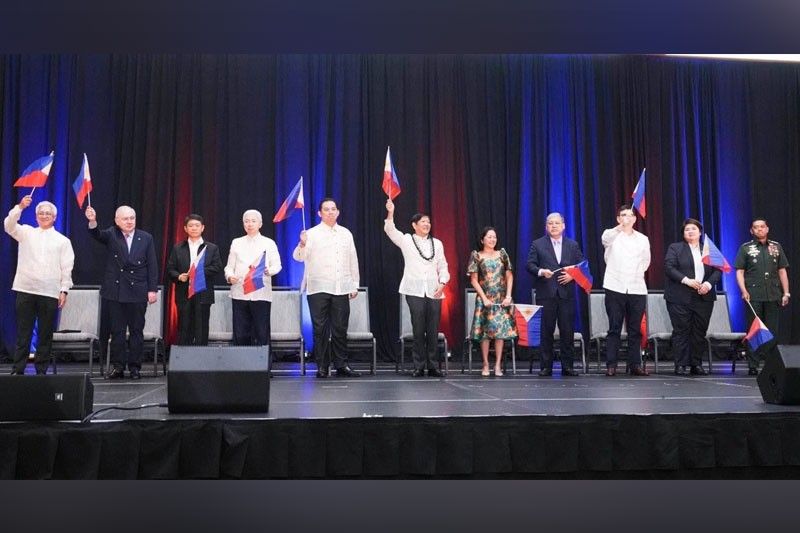President Marcos in Hawaii for final leg of US trip

MANILA, Philippines — The Marcoses entered what could be their darkest days in 1986, when the dictatorship was toppled and the family banished to Hawaii while hounded by allegations of human rights violations and corruption.
More than three decades later, President Marcos, who was in his late 20s when his father and namesake was ousted in a popular revolt, returned to Hawaii as the leader of the Philippines to reconnect with people who did not abandon them during their lowest point.
Marcos, now 66, was nostalgic when he faced the Filipino community yesterday, heaping praises on people whom he said “kept the body and soul of the Marcos family.”
He said the Marcoses landed at Hickam Air Force Base from Malacañang in 1986 with nothing. According to the President, Filipinos provided them with clothes, appliances and other necessities, keeping his family “literally alive.”
“We could not have survived that very difficult period if not for you,” the President told a crowd of about a thousand people at the Hawaii Convention Center.
“And that is something that I will carry in my heart, that the Marcos family will carry in our heart. We tell our children about this and how wonderful you all were to us in the time that we were here,” he added.
Marcos said people do not believe him whenever he tells the story of his family’s exile.
“But I tell them, you do not realize how – how close we became and how kind and how generous the people – the Filipino Americans in Hawaii were,” he added.
The Marcoses were banished to Hawaii after their patriarch, the late president Ferdinand Marcos, was ousted in the 1986 people power revolution. They lived in exile until 1991.
A New York Times article published in 1988 quoted friends and associates of former first lady Imelda Marcos as saying that she and her husband still enjoyed the “high life they were accustomed to in Manila.”
According to the article, the Marcoses were “hosts to weekly Sunday afternoon gatherings and lavishly catered dinners at their multimillion-dollar Makiki Heights estate and dinner parties at some of the most expensive restaurants in town.”
An Associated Press article published on July 31, 1991 said the government of then president Corazon Aquino allowed Imelda to return to the Philippines from her exile to put her on trial and “lay to rest” the remaining ghosts “of her husband’s 20-year dictatorship.”
In 1993, the body of the elder Marcos, who died in exile nearly four years earlier, arrived in the Philippines. Incidentally, the younger Marcos’ visit to Hawaii coincided with the seventh anniversary of the controversial burial of the late president to the Libingan ng mga Bayani, which was allowed by former president Rodrigo Duterte in 2016 despite protests by human rights groups and martial law victims.
Marcos said he could have traveled directly to Manila after attending the Asia-Pacific Economic Cooperation summit in San Francisco, but decided to drop by Honolulu to visit his friends.
“So I said, we have to go down — we have to land in Hawaii. I have to say hello to all our friends in Hawaii... The Filipinos and the Filipino Americans in Hawaii hold a very special place in my heart for all the wonderful experiences that we had here with our Filipino compatriots,” he said, drawing loud cheers from his audience.
“On behalf of my entire family, my father is gone, but when my mother found out that I was coming to Honolulu, she said you make sure that you go back to all of those people who went out of their way to keep us comfortable, to keep us alive, literally alive.”
Marcos’ visit to Hawaii is the last leg of his week-long trip to the US. His plane landed at the Daniel K. Inouye International Airport at 1:13 p.m. yesterday, Philippine time.
The President is also scheduled to meet with security officials of the US Indo-Pacific Command and attend a roundtable discussion with the Daniel K. Inouye Asia-Pacific Center for Security Studies.
The Indo-Pacific Command covers about half the earth’s surface, has about 375,000 military and civilian personnel and is supported by multiple component and sub-unified commands including US Forces Korea, US Forces Japan, US Special Operations Command Pacific, US Pacific Fleet, US Marine Forces Pacific, US Pacific Air Forces and US Army Pacific.
- Latest
- Trending






























